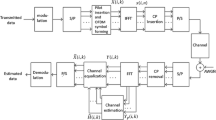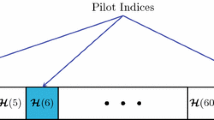Abstract
In this paper, we present a channel estimation method based on two-dimensional signal spreading applicable to orthogonal frequency multiple access multicarrier systems. Our method exploits a spreading of a transmitted data signal as well as a pilot signal over the assigned frequency range and time period. As a spreading sequence we exploited orthogonal Walsh–Hadamard sequences. When compared with traditional pilot symbol based channel estimation, our method is beneficial in low signal to noise ratio (SNR). For a comparison of our method with state-of-the-art channel estimation method, we utilized an open source LTE downlink simulator developed at TU Vienna. This enables a reproducibility of our results. Considering the LTE system, our method outperforms the traditional approach in typical range of SNR from \(-\)5 to 10 dB. For a comparison of a throughput performance, a number of channel models has been employed.








Similar content being viewed by others
References
Li, Y. (2000). Pilot-symbol-aided channel estimation for OFDM in wireless systems. IEEE Transactions on Vehicular Technology, 49(4), 1207–1215.
Hoeher, P., Kaiser, S., & Robertson, P. (1997). Pilot-symbol-aided channel estimation in time and frequency. In Multi-carrier spread-spectrum (pp. 169–178). Springer, US.
Dong, X., Lu, W.-S., & Soong, A. (2007). Linear interpolation in pilot symbol assisted channel estimation for OFDM. IEEE Transactions on Wireless Communications, 6(5), 1910–1920.
Lee, S., Kwak, K., Kim, J., & Hong, D. (2008). Channel estimation approach with variable pilot density to mitigate interference over time-selective cellular OFDM systems. IEEE Transactions on Wireless Communications, 7(7), 2694–2704.
Simko, M., Pendl, S., Schwarz, S., Wang, Q., Ikuno, J. C., & Rupp, M. (2011). Optimal pilot symbol power allocation in LTE. In Vehicular Technology Conference (VTC Fall), 2011 IEEE (pp. 1–5). IEEE.
Edfors, O., Sandell, M., Van de Beek, J.-J., Wilson, S. K., & Borjesson, P. O. (1998). OFDM channel estimation by singular value decomposition. IEEE Transactions on Communications, 46(7), 931–939.
Atarashi, H., Abeta, S., & Sawahashi, M. (2003). Variable spreading factor-orthogonal frequency and code division multiplexing VSF-OFCDM for broadband packet wireless access. IEICE Transactions on Communications, 86(1), 291–299.
Fazel, K., & Kaiser, S. (2008). Multi-carrier and spread spectrum systems: From OFDM and MC-CDMA to LTE and WiMAX. Wiley. [Online]. Available: http://books.google.com/books?id=RzUJsPqe-dgC.
Sesia, S., Toufik, I., & Baker, M. (2009). LTE-the UMTS long term evolution: From theory to practice. New York: Wiley.
Blumenstein, J., Simko, M., Marsalek, R., Fedra, Z., Prokopec, J., & Rupp, M. (2012). Two dimensional signal spreading in umts lte: Exploiting time-frequency diversity to increase throughput. Wireless Personal Communications, pp. 1–11. [Online]. Available doi:10.1007/s11277-012-0864-3.
Mehlführer, C., Ikuno, J. C., Šimko, M., Schwarz, S., Wrulich, M., & Rupp, M. (2011). The Vienna LTE simulators—enabling reproducibility in wireless communications research. EURASIP Journal on Advances in Signal Processing, 2011, 1–13.
Mehlführer, C., Wrulich, M., Ikuno, J. C., Bosanska, D., & Rupp, M. (2009). Simulating the long term evolution physical layer. In Proc. of the 17th European Signal Processing Conference (EUSIPCO 2009), Glasgow, Scotland, Aug. 2009. [Online]. Available: http://publik.tuwien.ac.at/files/PubDat_175708.pdf.
Blumenstein, J., Ikuno, J. C., Prokopec, J., & Rupp, M. (2011). Simulating the long term evolution uplink physical layer. In ELMAR, 2011 Proceedings (pp. 141–144). IEEE.
Recommendation ITU-R M.1225: Guidelines for evaluation of radio transmission technologies for imt-2000, Tech. Rep., Tech. Rep. (1997).
3GPP, Technical specification group radio access network; deployment aspects (release 7), 3GPP, Tech. Rep. 25.943 V7.0.0, (Jan 2007).
3GPP Technical Specification Group RAN, E-UTRA; physical channels and modulation, 3GPP, Tech. Rep. TS 36.211 Version 8.7.0, (May 2009).
3GPP Technical Specification Group RAN, E-UTRA; multiplexing and channel coding, 3GPP, Tech. Rep. TS 36.212, (March 2009).
3GPP Technical Specification Group RAN, E-UTRA; physical layer procedures, 3GPP, Tech. Rep. TS 36.213, (March 2009).
Omar, S., Ancora, A., & Slock, D. T. M. (2008). Performance analysis of general pilot-aided linear channel estimation in LTE OFDMA systems with application to simplified MMSE schemes. In Personal, Indoor and Mobile Radio Communications, 2008. PIMRC 2008. IEEE 19th International Symposium on (pp. 1–6).
Liu, S., & Trenkler, G. (2008). Hadamard, Khatri-Rao, Kronecker and other matrix products. International Journal of Information and Systems Sciences, 4(1), 160–177.
Assalini, A., Dall’Anese, E., & Pupolin, S. (2009). Linear MMSE MIMO channel estimation with imperfect channel covariance information. In Communications, 2009. ICC’09. IEEE International Conference on (pp. 1–5).
Acknowledgments
This work was supported by the Czech Science Foundation project No. 13-38735S Research into wireless channels for intra-vehicle communication and positioning, and was performed in laboratories supported by the SIX project, No. CZ.1.05/2.1.00/03.0072, the operational program Research and Development for Innovation. The cooperation in the COST IC1004 action was supported by the MEYS of the Czech Republic project no. LD12006 (CEEC). The authors would like to acknowledge the contribution of Christian Doppler Laboratory for Wireless Technologies for Sustainable Mobility.
Author information
Authors and Affiliations
Corresponding author
Rights and permissions
About this article
Cite this article
Blumenstein, J., Maršálek, R., Fedra, Z. et al. Channel Estimation Method for OFDM in Low SNR Based on Two-dimensional Spreading. Wireless Pers Commun 78, 715–728 (2014). https://doi.org/10.1007/s11277-014-1779-y
Published:
Issue Date:
DOI: https://doi.org/10.1007/s11277-014-1779-y




